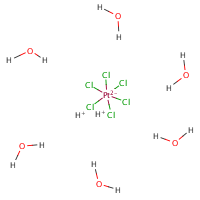Platinic chloride hexahydrate
Agent Name
Platinic chloride hexahydrate
Alternative Name
Chloroplatinic acid hexahydrate
CAS Number
18497-13-7
Formula
Cl6-Pt.2H.6H2-O
Major Category
Metals

Synonyms
Dihydrogen hexachloroplatinate hexahydrate; Hydrogen hexachloroplatinate(IV) hexahydrate; Dihydrogen hexachloroplatinate(IV) hexahydrate; Platinate(2-), hexachloro-, dihydrogen, hexahydrate; Platinate(2-), hexachloro-, dihydrogen, hexahydrate, (OC-6-11)-; [ChemIDplus] UN2507
Category
Metals, Inorganic Compounds
Description
Brownish-yellow solid; Highly deliquescent; Soluble in water; [Merck Index] Brown odorless lumps; Hygroscopic; [Alfa Aesar MSDS]
Sources/Uses
Used in plating, photography, mirrors, indelible inks, luster on glass, and acetic acid manufacturing; Also used for platinizing pumice stone, catalyzing sulfur trioxide production, relief etching of zinc (artistic and commercial applications), and fixing microscope preparations; [Merck Index]
Comments
May cause asthma or dermatitis; [Merck Index] Causes burns; Inhalation may cause corrosive injuries to upper respiratory tract and lungs; May cause skin and respiratory sensitization; Toxic by ingestion; [Alfa Aesar MSDS] See "Platinum, soluble salts."
Biomedical References
Exposure Assessment
TLV (ACGIH)
0.002 mg/m3, as Pt
PEL (OSHA)
0.002 mg/m3, as Pt
Explanatory Notes
The Guide in the Emergency Response Guidebook is for "Chloroplatinic acid, solid."
Adverse Effects
Skin Sensitizer
Yes
Asthma
Yes
Toxic Pneumonitis
Yes
Dermatotoxin
Skin burns
Diseases, Processes, and Activities Linked to This Agent
Diseases
Occupational diseases associated with exposure to this agent:
Processes
Industrial Processes with risk of exposure: